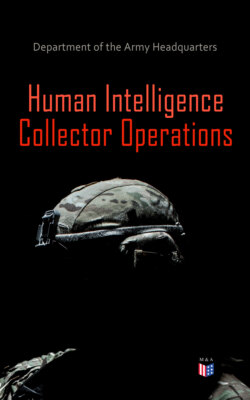Читать книгу Human Intelligence Collector Operations - Department of the Army Headquarters - Страница 6
INTELLIGENCE PROCESS
Оглавление1-2. Intelligence operations consist of the functions that constitute the intelligence process: plan, prepare, collect, process, produce, and the common tasks of analyze, disseminate, and assess that occur throughout the intelligence process. Just as the activities of the operations process overlap and recur as circumstances demand, so do the functions of the intelligence process. Additionally, the analyze, disseminate, and assess tasks of the intelligence process occur continuously throughout the intelligence process. (See Figure 1-1.)
Plan. This step of the intelligence process consists of activities that include assessing the situation, envisioning a desired outcome (also known as setting the vision), identifying pertinent information and intelligence requirements, developing a strategy for ISR operations to satisfy those requirements, directing intelligence operations, and synchronizing the ISR effort. The commander’s intent, planning guidance, and commander’s critical information requirements (CCIRs) (priority information requirements [PIRs] and friendly force information requirements [FFIRs]) drive the planning of intelligence operations. Commanders must involve their supporting staff judge advocate (SJA) when planning intelligence operations (especially HUMINT operations). Planning, managing, and coordinating these operations are continuous activities necessary to obtain information and produce intelligence essential to decisionmaking.
Prepare. This step includes those staff and leader activities that take place upon receiving the operations plan (OPLAN), operations order (OPORD), warning order (WARNO), or commander’s intent to improve the unit’s ability to execute tasks or missions and survive on the battlefield.
Collect. Recent ISR doctrine necessitates that the entire staff, especially the G3/S3 and G2/S2, must change their reconnaissance and surveillance (R&S) mindset to conducting ISR. The staff must carefully focus ISR on the CCIR but also enable the quick re-tasking of units and assets as the situation changes. This doctrinal requirement ensures that the enemy situation, not just our OPLAN, “drives” ISR operations. Well-developed procedures and carefully planned flexibility to support emerging targets, changing requirements, and the need to support combat assessment are critical. The G3/S3 and G2/S2 play a critical role in this challenging task that is sometimes referred to as “fighting ISR” because it is so staff intensive during planning and execution (it is an operation within the operation). Elements of all units on the battlefield obtain information and data about enemy forces, activities, facilities, and resources as well as information concerning the environmental and geographical characteristics of a particular area.
Process. This step converts relevant information into a form suitable for analysis, production, or immediate use by the commander. Processing also includes sorting through large amounts of collected information and intelligence (multidiscipline reports from the unit’s ISR assets, lateral and higher echelon units and organizations, and non-MI elements in the battlespace). Processing identifies and exploits that information which is pertinent to the commander’s intelligence requirements and facilitates situational understanding. Examples of processing include developing film, enhancing imagery, translating a document from a foreign language, converting electronic data into a standardized report that can be analyzed by a system operator, and correlating dissimilar or jumbled information by assembling like elements before the information is forwarded for analysis.
Produce. In this step, the G2/S2 integrates evaluated, analyzed, and interpreted information from single or multiple sources and disciplines into finished intelligence products. Like collection operations, the G2/S2 must ensure the unit’s information processing and intelligence production are prioritized and synchronized to support answering the collection requirements.
1-3. For more information on the Intelligence process, see FM 2-0.
